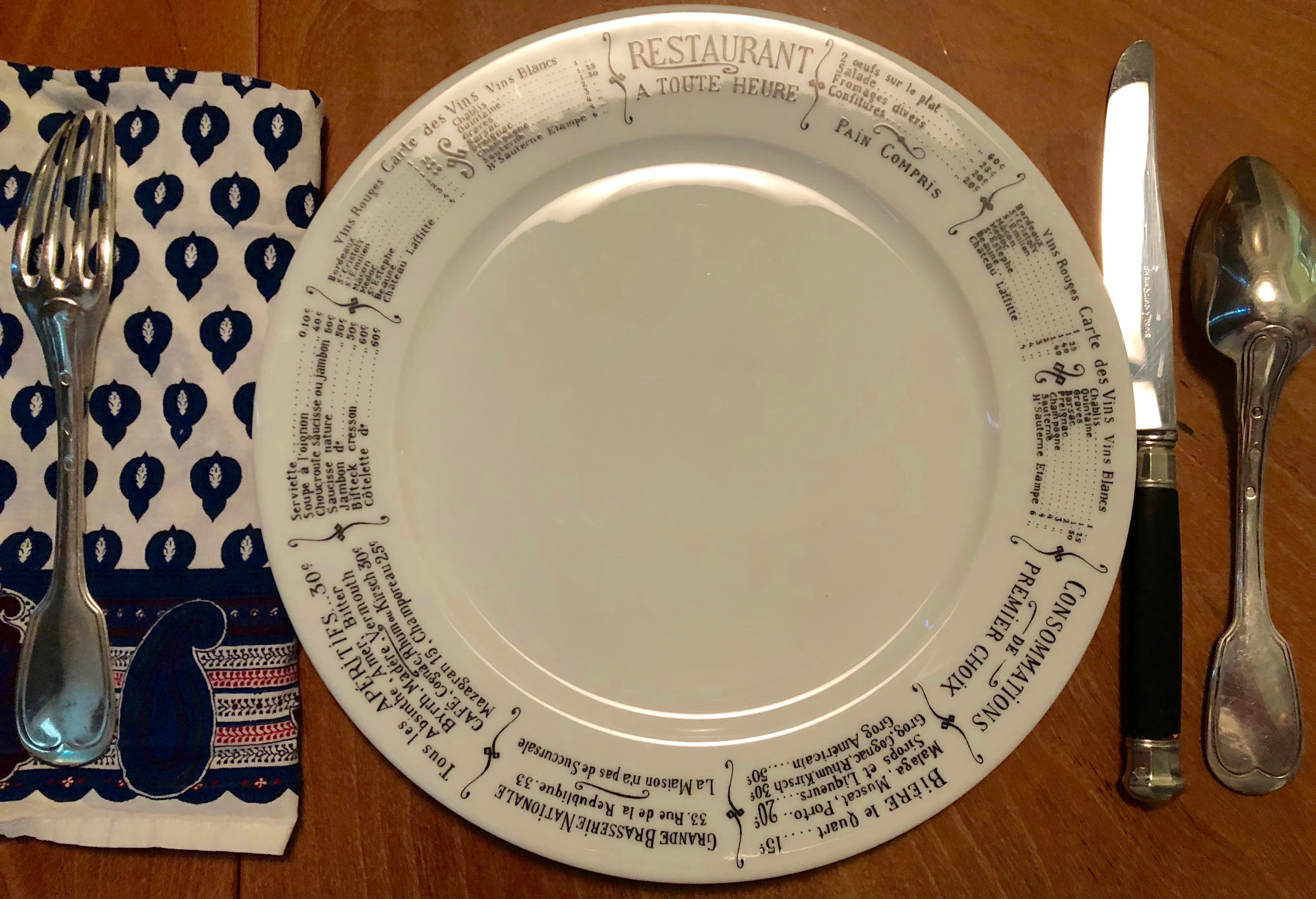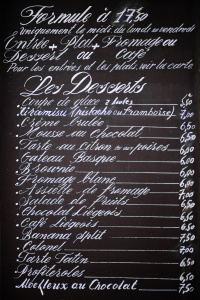Restaurant How To

Restaurant how to. You may be thinking you don’t need instructions on how to order food. But, it is a different culture in Paris. A few key suggestions for restaurant how to will go a long way to making your restaurant experiences more enjoyable. And, most are not restaurant how to, more explanation. Take a look.
If you are walking by a restaurant and decide it looks good, take a look at the menu. All restaurants have the menu posted outside. Probably best to avoid restaurants who have hawkers out on the street trying to get you to come in.
Meal Time
For sit-down meals, you can only expect service at standard dining hours. It is pretty much a set rule at restaurants that are not tourist traps. Lunch is from12-2 pm (12:00 – 14:00) and dinner is from 7-10 pm (19:00 – 22:00). At dinner, some restaurants will open earlier, so make sure to check the hours if you want to eat earlier.
Service continu – meals served all day (between the normal closed time of 2p and 7p), so look for that sign if you are really hankering for a sit down mean on off hours.
Sundays
Many restaurants and stores are closed on Sundays. This could be a day to plan ahead for a picnic. Or, if you didn’t plan ahead, stop in at one of the little tiny stores usually run by non-Parisians to gather provisions. Because many places are closed, Sunday is a great day to plan a meal or a snack while visiting a park.
Understanding English
If the restaurant is listed in American guidebooks, the people will be familiar with English-speaking visitors. This is not bad. Places that have good food get good reviews. It is completely fine to have a cosmopolitan waiter who speaks a little English. Just remember to start out with, “bonjour.” Then, the waiter will likely help you in English.
Timing
You will be seated. Never sit down at a table, even if it is outside, without a waiter or the host or hostess seating you. Did the host ask how many? You will need to provide a number. Generally I find it easier to hold up fingers. Simple, understandable and no mistakes. Plus, they will know you are American if you hold up your forefinger, middle finger and ring finger, pinky finger and more. (Europeans use their thumb for one.)
Squeeze in at the table. Then, the waiter will present menus and maybe bring over a bottle of water, or ask what kind of water you would like. Potentially, you can order a glass of wine or a drink at this time too.
Then, in a few minutes, the waiter will come to take your order – all at once. That means, review the menu when it is given to you. Make your choice and be ready to order drinks, appetizer and main course when the waiter returns. The French do not really order appetizers and then later, order the main course.
You do not have to order dessert at this time. Although you may want to look at the dessert offering to help determine how heavy of a main course you want.
Soon, your appetizers will be delivered to the table followed by the mains. The timing of the meal delivery is generally just right. After the main course, you can linger as long as you want to talk or just relax. The waiters get it moving up front, then give you all the time you want.
Cocktails
Paris has actual cocktail bars with professional mixologists. But, in restaurants, you are not likely to find extensive variety for cocktails. Wine, yes. Cocktails, not so much. On one visit, a friend kept ordering margaritas at every restaurant we went to. Every time, he was disappointed. Unless you are in a cocktail bar, don’t be overly confident in the bar tender’s ability to make your favorite drink.
Menu Specials

Fixed price menu. Plus look at the desserts!
A nice “restaurant how to” is how to order the specials to have a variety of flavors at a potentially lower price! Restaurant often have what I call plate lunch specials. Although, Parisian restaurants do not serve it all on one plate! These specials come in multiple courses and usually save you some coin. Good food, good price, let’s eat!
Plat du Jour – “plate of the day”
I call it the daily plate lunch special (or dinner special), that usually has no choices for you to make.
Prix Fixe or Formule – “fixed price”
Another special, usually 3 courses for a set price and you may have a choice of main courses.
Table d’Hôte – “table of the host”
Or, loosely meaning “chef’s special.” A name not used as much anymore in Paris, will have to research why, but generally a daily special with no choices on this one either.
Menu dégustation – “tasting menu”
A meal created by the chef that has many small “tasting” bites. This way you get to try a lot of different flavors rather than having one or two courses.
Ordering
Order straight from the menu presented. Do not order something on the side, do not ask for substitutions, the waiter will think you are from the moon and will not accommodate you. So avoid problems with this restaurant how to.
If you have a food allergy, look up the name of your allergy before you go. Write it on a piece of paper and bring it in your satchel. Say discreetly to the waiter, “s’il vous plait” (seal-voo-play) and show him your note. That way there is no confusion. The waiter will understand, and for a real health issue, they will accommodate you.
Order of Service
You may not order all of these courses, but this is the general order of service for French dining
- aperitif
- hors d’oeuvres/appetizer
- fish
- main course
- salad
- cheese
- dessert
- coffee
The French serve coffee after the meal is completely over. They do not have coffee and dessert at the same time. Coffee follows at the end.
Payment
After serving your meal, the waiter will most likely not return until you request attention. When you are ready to pay, you can catch the waiter’s eye and make the universal sign of a check mark – sure way to get the bill. Or, if the waiter is passing, you could quietly say, “l’addition, s’il vous plait” (lah-dishyohw seal-voo-play).
The waiter will bring over a small plate with the bill on it. He or she will place it on the table and walk away. Place your payment method on the tray. The waiter will return. If you pay with cash, the waiter will return with change. Should you use a credit card, the waiter will leave and bring the machine to the table to process your card.
Tipping
At sit down restaurants, payment for service – the tip – is included in the bill that is presented to you for payment. You will see it on your receipt as “Service Compris.” An extra tip is not expected. But, you can leave the change on the table or round up to the next Euro. For example, at a café, you can round up the cents. Say the bill for coffee is 2.80 Euros, you may round up to 3 Euros when you pay.
If you had particularly good service, leave a Euro or two for the waiter. Think in the range of 1-2 Euros for each 20 Euros of the check. At more expensive restaurants, consider a 10 or 20 Euro note depending on the final bill and the service you received. And, like in the United States, if you make a big mess or have messy children, tip accordingly.
To note: If you pay with a credit card, most likely you cannot add the tip onto the credit card payment like we do in the United States. That means you will have to dig in your pocket for some coins if you appreciate the service.
Extras – Restaurant How To
It has been explained on multiple occasions that dogs “manger,” and people “diner.” Never have forgotten that one. Here, of course we say eat. There, never.
Also, people do not say that they are full – completely inappropriate. But, you can say, “c’était délicieux” (say-tay day-lish-ee-use) (that was delicious). That sums it all up. A great meal in Paris. Tell the waiter, earn American good will and walk the streets of Paris after you leave.
When the waiter comes to take your order, you may hear, “Je vous écoute.” (zhe-voos-eh-coot) The literal translation is “I am listening,” but it is also, what would you like?
At the end of a course, you may hear, “terminé?” (tur-me-nay) “Are you finished?”
When you are busting at the seams, you may hear, “dessert?” (day-sayr) Same word in English, but different pronunciation. Order up!
Whatever they are saying, it is usually so fast!!!! Just think of what the next part of the meal is and anticipate the question. If you anticipate wrong, and you have been a good guest, the waiter will help you out.
